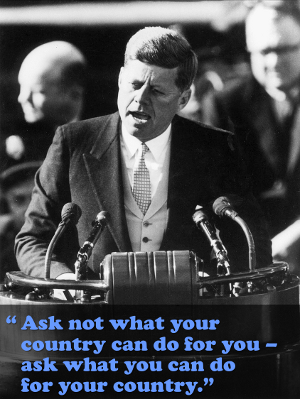| Home » Articles » Speech Writing |
One way to breathe life into your speeches is to craft memorable phrases that will linger on the lips of your audience, and a great tool to help you achieve this goal is chiasmus. In this article, we define what chiasmus is, study several famous (and not-so-famous) chiasmus examples, and give some tips for crafting chiasmus into your own speeches.
What is Chiasmus? A Definition…Chiasmus is a Greek term meaning “diagonal arrangement.” It is used to describe two successive clauses or sentences where the key words or phrases are repeated in both clauses, but in reverse order. For this reason, chiasmus is sometimes known as a criss-cross figure of speech. For example, consider the common phrase:
“Going” and “tough” are reversed in successive clauses, while the other words (when, the, gets) bind them together and often include straightforward repetition (the, get/gets). In the general pattern, when your first clause contains two words A and B, then the second clause contains the same words, but in reverse order:
Each of “A” and “B” can be either a single word, or a group of words. Graphically, it looks like this:
Isn’t that antimetabole?Some rhetorical glossaries distinguish between chiasmus (diagonal arrangement of ideas and grammar) and antimetabole (diagonal arrangement of exact words). According to this, every example on this page is antimetabole. However, chiasmus is the more common term, and this subtle distinction is probably beyond what most speakers care about. So, I’ll follow the lead of those who describe both as chiasmus, like Jay Heinrichs. The key point is not knowing what it is called, but rather using it in your speeches! Chiasmus from John F. KennedyChiasmus was a common technique used by John F. Kennedy (or perhaps his speechwriters). We include just a few of his chiastic phrases here. For example, the most famous line from his Inaugural Address (January 20, 1961) reverses your country and you in successive parallel clauses:
In the same speech, he says:
In his address to the United Nations General Assembly on September 25, 1961, he repeats that line, slightly massaged to reflect his audience and his relationship to it:
The same speech includes:
Finally, his 1963 address on the Nuclear Test Ban Treaty includes:
More Chiasmus ExamplesWinston Churchill used chiasmus in his Iron Curtain speech (March 5, 1946):
Ronald Reagan, speaking of relations between the United States and Soviet Union:
Barack Obama, in 2006:
Bill Clinton, 2008 Democratic National Convention:
Sarah Palin, 2008 Republican National Convention:
Chiasmus in the BibleThere are entire websites devoted to Biblical passages built around chiastic patterns. Here, we include just a couple from the New Testament: Matthew 19:30 …
Matthew 23:12 …
Chiasmus in MusicCrosby Stills, Nash & Young sang a famous song titled “Love the One You’re With”:
Chiasmus in LiteratureWilliam Shakespeare, Richard II:
The motto of Alexandre Dumas’ The Three Muskateers, (and also the unofficial motto of Switzerland):
Horton the elephant’s signature phrase in Dr. Seuss’ Horton Hatches the Egg:
Chiasmus in AdvertisingBand-Aid brand adhesive bandages:
Chiasmus in Everyday SayingsFrom popular wisdom:
Or…
Or…
A Guide for Using Chiasmus in Your SpeechesIt’s not that hard to create your own chiasmus for your speeches. I crafted several of the examples in this article in just a few minutes, including this one:
It’s not as polished as “Ask not…”, but you’ve got to start somewhere. To help you along, here are a few guidelines:
Guideline 1: Use with ModerationChiasmus, like most rhetorical devices, is best when used in moderation. If you use chiasmus over and over again, you’ll diminish the impact, and you’ll start to sound gimmicky. For most speeches, one or two is enough. Guideline 2: Rethink RelationshipsKennedy’s most famous chiasmus plays on the relationship between the country and the individual. The criss-cross invites his audience to rethink the relationship between the two. You, too, can take relationships and flip them around. Consider the relationship between a speaker and the audience:
Or, the relationship between parents and children:
Guideline 3: Question CausationSeveral famous chiastic phrases play on the causation between two entities. For example, the quotation from Ronald Reagan above questions whether arms cause mistrust, or whether mistrust causes arms:
Try taking other concepts and flipping them around. For example, in a speech questioning whether failure causes despair, or vice versa:
Guideline 4: Riff off Chiasmus ExamplesIf you’ve never tried to craft chiasmus before, a good place to start is taking a known chiasmus and using it as a template into which you can substitute one or both key repeated words. Cicero is quoted as saying:
This has been morphed numerous ways, including:
You could take the basic pattern and apply it your situation. For example, a speech about passion while speaking might include:
While researching this article, I came across an intriguing book titled Never Let a Fool Kiss You or a Kiss Fool You by Mardy Grothe. With hundreds of chiasmus examples, there’s an awful lot to riff off of. I may have to add this to my Christmas list. Your Turn: Try it Out!With a little brainstorming and experimentation, you can elevate your speeches with chiasmus. | |
| Views: 455 | |
| Total comments: 0 | |

